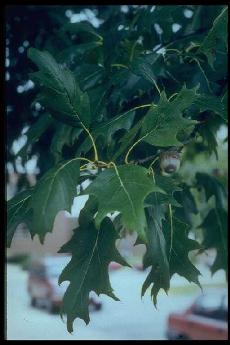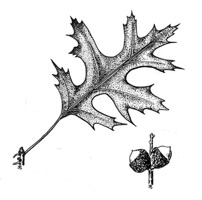Red Oak


RED OAK - Quercus rubra
(beech family)
TOXICITY RATING: Moderate high.
ANIMALS AFFECTED: All animals may potentially be affected, but the primary risk is to cattle.
DANGEROUS PARTS OF PLANT: Buds (fall), young shoots (early spring), sprouts, acorns.
CLASS OF SIGNS: Poor doer, poor
appetite, weight loss, diarrhea or constipation, increased
drinking, increased urination, edema, death is possible.
PLANT DESCRIPTION: Oaks are trees with leaves that turn brown but hang on through the winter. In the southwestern U.S., Gambel's oak, shinnery oak, and post oak frequently cause poisonings. In our part of the country, red oak has produced problems. Red oak is a large tree of well-drained woodlands, parks, and home plantings that bears broad-bladed leaves with deep lobes ending in bristle-tips (fig. 47). The fruit is the familiar nut borne in a scaly cup and called an acorn (fig. 47A).
SIGNS: This discussion refers primarily to cattle, the species most often affected by oak toxicosis. It also seems that cattle less than 2 years of age succumb to oak toxicosis more than do older animals, however older animals are still at risk. Other species at risk include sheep and possibly deer. Goats and swine are more resistant to poisoning, and horses are rarely affected (likely due to a unwillingness to consume oak). Pets rarely consume sufficient quantities to do harm. Many species of oak have been implicated in the poisoning of livestock, with red and black oak exhibiting greater toxicity than white oak.
While short-term acute poisoning by oak has been reported, the most commonly encountered oak poisoning is of a chronic nature. Oak is most dangerous early in the spring when the leaves and buds are the highest in toxicity and when there is little else to eat. The fall is another at risk period, when acorns and leaves fall and better forage dies back. Therefore, management plays a key role in preventing oak toxicosis.
The toxins in oak are called gallotoxins and are converted in the body to tannic acid, gallic acid and pyrogallol, all of which are very toxic to the kidney. It is the resulting kidney failure that causes the clinical signs. Typically, a significant amount of oak needs to be consumed over a period of time before clinical signs appear. Signs can develop over 2 to 14 days, or signs may be present with the animals becoming progressively worse over many weeks. The number of animals affected in the herd can vary greatly, but of those showing clinical signs, up to 80% may die. Signs of oak poisoning can include depression, lack of appetite, a gaunt and emaciated appearance, poor or rough hair coat, dependent edema (fluid buildup under the skin under the neck, abdomen or on the legs), digestive disturbances (both diarrhea and constipation have been reported, with mucus covered or tarry stools), increased drinking, passage of copious amounts of urine which may contain blood, and death.
FIRST AID: The most important step is to get the animals back on to plentiful and nutritious feed, and to limit stress, shipping and handling during the recovery period. Also, make sure that plenty of fresh water is always available, since affected cattle cannot maintain their own water balance very well while recovering. Since this is a long-term chronic toxicity, there is little in the way of an antidote to relieve signs. Severely or more chronically affected animals may not recover, but the less affected animals may, and may return to previous rates of gain and milk production. A veterinarian will be able to assist in management, and will be able to assist in emergency measures if large amounts of oak were recently consumed. Beyond this, treatment is supportive and symptomatic.
SAFETY IN PREPARED FEEDS: The toxin in oak remains when dry, so no feeds are safe that contain oak.
PREVENTION: Oak toxicosis is easily preventable with proper livestock and pasture management. Animals tend to eat oak only out of necessity, therefore by providing adequate and nutritious feed in the spring when the oak leaves bud out and again in the fall when leaves and acorns drop, the incidence of toxicosis should be minimized or eliminated.
![]()
![]()
 Wildflower
Seed For Sale
Wildflower
Seed For Sale